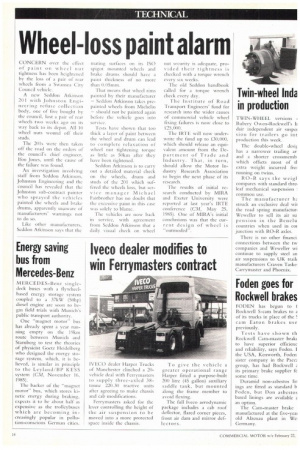Wheel-loss paint alarm
Page 14

If you've noticed an error in this article please click here to report it so we can fix it.
CONCERN over the effect of paint on wheel nut tightness has been heightened by the loss of a pair of rear wheels from a Swansea City Council vehicle.
A new Seddon Atkinson 201 with Johnston Engineering refuse collection body, one of five bought by the council, lost a pair of rear wheels two weeks ago on its way back to its depot. All 10 wheel nuts wound off their studs.
The 201s were then taken off the road on the orders of the council's chief engineer, !fon Jones, until the cause of the failure was found.
An investigation involving staff from Seddon Atkinson, Johnston Engineering and the council has revealed that the Johnston sub-contract painter who sprayed the vehicles painted the wheels and brake drums, apparently unaware of manufacturers' warnings not to do so.
Like other manufacturers, Seddon Atkinson says that the mating surfaces on its ISO spigot mounted wheels and brake drums should have a paint thickness of no more than 0.05mm.
That means that wheel rims painted by their manufacturer — Seddon Atkinson takes prepainted wheels from Michelin — should not be painted again before the vehicle goes into service.
Tests have shown that too thick a layer of paint between the wheel and drum can lead to complete relaxation of wheel nut tightening torque as little as 50km after they have been tightened.
Seddon Atkinson is to carry out a detailed material check on the wheels, drum and studs of the 201 which suffered the wheels loss, but service manager Michael Fairbrother has no doubt that the excessive paint in this case was solely to blame.
The vehicles are now back in service, with agreement from Seddon Atkinson that a daily visual check on wheel nut security is adequate, provided their tightness is checked with a torque wrench every six weeks.
The old Seddon handbook called for a torque wrench check every day.
The Institute of Road Transport Engineers' fund for research into the wider causes of commercial vehicle wheel fixing failures is now close to £25,0110.
The IRTE will now underwrite the fund up to £30,000, which should release an equivalent amount from the Depart m en t of Trade and Industry. That, in turn, should allow the Motor Industry Research Association to begin the next phase of its research.
The results of initial research conducted by MIRA and Exeter University were reported at last year's IRTE conference (CM, May 25, 1985). One of MIRA's initial conclusions was that the current design of wheel is "outmoded".
























































